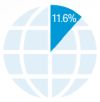Loyalty programs are central to the travel and hospitality industry. American Airlines was the first travel company to offer a loyalty program, in 1981. Hoteliers followed, with Marriott and Holiday Inn introducing programs in 1983. Soon after, credit card companies joined the field with Diners Club offering the ability to link rewards to customer spending. Other hospitality sectors, including quick service restaurants (QSRs), also have large and established loyalty programs.
Historically, the driver of many loyalty programs was catering to business travelers and their price insensitive travel patterns. As business travel struggles post-pandemic, many companies have turned from travel-based programs (based on number of miles, nights, etc.) to spend-based programs, enabled by co-branded credit cards. Others have changed their loyalty program structures to adapt to changing customer behaviors, the rise of leisure travel, trips blending work and personal interests, and rising consumer expectations.
 |
The World Travel & Tourism Council forecasts that the travel sector will grow its GDP contribution to $15.5 trillion by 2033, representing 11.6 percent of the global economy.¹ |  |
The World Travel & Tourism Council forecasts that the travel sector will grow its GDP contribution to $15.5 trillion by 2033, representing 11.6 percent of the global economy.2 |
In this market, where customer behavior is changing and
unpredictable, an effective loyalty scheme is invaluable. Travel
companies cannot afford to give up any share of what is already an
ultra-competitive marketplace.
A&M believes four forces will significantly impact how travel and hospitality loyalty programs operate in the future. Companies must understand the impact of these forces on their loyalty programs at both the customer and P&L level. Any changes to loyalty programs must be carefully and thoughtfully communicated to avoid customer pushback and negative brand impact.
Companies adept at transforming loyalty from a transactional event into a personal brand connection will drive growth and enhance the perceived customer value of their brand. This strategic shift not only improves profitability but also significantly boosts EBITDA contributions. To do so, companies must thoughtfully navigate the impact of the strategic forces discussed below.
Four Forces Changing the Dynamics of Loyalty Programs in the Travel and Hospitality Industry
These forces will have a significant impact on both the perceived customer value and profitability of loyalty programs.
Market Saturation – Based on a 2022 report, on average, U.S. consumers already belong to 16.6 loyalty rewards programs, had an active subscription to 1.8 payment cards loyalty programs and 0.9 travel loyalty programs with new loyalty programs choices coming online every day.3 Recently, the success of a loyalty program has been measured in new customer acquisition, primarily measured by the growth of co-branded credit card programs. In 2022, the largest US credit card issuer received $28.1 BN in interchange income and paid out $22.2 BN to partners, either directly or indirectly (in the form of cardholder rewards).4 A recent study by Research and Markets projects a 9.6% CAGR for co-branded credit cards between 2023 and 2030.5 While this growth will create more options for consumers, it will force companies to compete more to differentiate their co-branded cards from other options — be it from direct industry competitors or financial institutions which offer travel-related redemption options via non-co-branded cards or other channels. Moreover, slowing economic conditions, rising interest rates, and proposed interchange and late fee revenue caps will force tightening of credit underwriting standards (approvals and lines) and negatively impact card holder spending and overall program profitability. As such, many companies will soon reach a point of resistance where the ability and cost to acquire new co-branded card users will be prohibitive. Companies with large global footprints such as Marriott — which recently began issuing cards in India, its tenth international market — will be able to mitigate these risks, but most companies without global size and scale will encounter significant challenges to credit card-related loyalty growth.
Capacity Limitations – One of the clearest customer value propositions for loyalty programs is the ability to redeem points for free products — rooms, airline seats, meals, etc. Holders of mass-market general-purpose cards earned an estimated $41.1 billion in rewards in 2022, a 58 percent increase from $26.1 billion in 2019. Of the three primary rewards channels (cash back, miles and points), points growth drove most of the increase.6 Recent widespread and fast-track status achievement has resulted in lack of redemption options, overcrowding in lounges, long lines and the feeling that if everyone is special then no one is special. Travel and Hospitality companies must delicately balance their loyalty redemptions against paid transactions to avoid diluting the premium experience while maximizing profitability and the perceived value of their loyalty programs.
The challenge is that travel demand, while waning somewhat, is still relatively high and therefore travel companies are still able to command premium pricing for their products. There are also several external factors which are limiting capacity not only for paying customers but also for those looking to redeem points – high interest rates slowing down the ability for lodging companies to fill the hotel development pipeline, continued supply chain issues slowing the ability for airlines to bring on new planes with added capacity and premium seating, limited space in airports restricting credit card companies and airlines to expand lounges.
Shifting Behaviors – Travel and hospitality consumption behaviors and patterns before the pandemic no longer apply. Over the past several years, leisure travel has been the engine that drove recovery in the travel industry. Group and small-to-medium business travel has nearly recovered to pre-pandemic levels; large corporate travel is still depressed with many travel and hospitality companies reporting that the large corporate segment has only returned to 75–80 percent of pre-pandemic levels. Traditional travel days have shifted with the rise of "bleisure" travel with extended stays but altering peak and shoulder travel days. Within the leisure space, demand in North American domestic travel shifted to international travel during the summer of 2023, causing significant revenue impacts to travel and hospitality brands that have a limited geographical footprint. Other behavior shifts, ranging from increasing expectations of sustainable/eco-friendly tourism, desire for more experiential versus transactional benefits and continued uncertainty of a potential recession will impact travel and hospitality-related spend in 2024. To stay relevant and attractive, companies must be able to quickly pivot their loyalty offerings to address, and take advantage of, constantly changing travel trends.
Footnotes
1. https://wttc.org/news-article/global-travel-and-tourism-catapults-into-2023-says-wttc
2. https://finance.yahoo.com/news/global-loyalty-programs-market-2023-221500335.html
3. https://www.statista.com/statistics/1238880/membership-loyalty-programs-us-by-sector/
4. https://bankingandpaymentsgroup.com/co-branded-credit-cards-the-allure-and-the-reality/
5. https://www.researchandmarkets.com/report/co-branded-card
6. https://files.consumerfinance.gov/f/documents/cfpb_consumer-credit-card-market-report_2023.pdf
To view the full article click here
The content of this article is intended to provide a general guide to the subject matter. Specialist advice should be sought about your specific circumstances.






